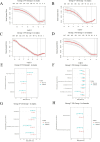Multi-trajectories of BMI, waist circumference, gut microbiota, and incident dyslipidemia: a 27-year prospective study
- PMID: 40293249
- PMCID: PMC12090771
- DOI: 10.1128/msystems.00243-25
Multi-trajectories of BMI, waist circumference, gut microbiota, and incident dyslipidemia: a 27-year prospective study
Abstract
Evidence is insufficient to establish a longitudinal association between combined trajectories of body mass index (BMI) and waist circumference (WC) and dyslipidemia. This study investigated the associations between multi-trajectories of BMI and WC over 24 years and the subsequent risk of dyslipidemia in a large cohort of 10,678 Chinese adults from the China Health and Nutrition Survey. Utilizing a group-based trajectory model, we identified four distinct trajectories: normal, normal-increasing, overweight-increasing, and obesity-increasing. Our results indicated that ascending trajectories of BMI and WC are significantly associated with increased odds of dyslipidemia, particularly in males, with odds ratios (OR) of 2.10, 2.69, and 3.56 for the normal-increasing, overweight-increasing, and obesity-increasing groups, respectively. Among females, the normal-increasing group exhibited a significant increased risk (OR: 1.54). Furthermore, we explored the gut microbiota associated with these trajectories, identifying 3, 8, and 4 bacterial genera linked to increasing BMI and WC in males, alongside two genera in females with the normal-increasing trajectory. We identified a total of 23, 25, and 10 differential metabolites significantly associated with these genera, except for Group 2 in males. The inclusion of relevant microbiome and metabolite data improved the model's predictive capacity for the risk of dyslipidemia, with ROC values increasing from 0.655 to 0.875. Our findings underscore the critical implications of continuous weight gain on metabolic health and suggest that gut microbiota may play a pivotal role in understanding these associations.IMPORTANCEEmerging evidence suggests a close connection between the gut microbiome and both human obesity and dyslipidemia, suggesting that the gut microbiome may play an important role in the obesity-dyslipidemia relationship. In this study, we observed several characteristic genera, including Clostridium_sensu_stricto_1, Turicibacter, and CHKCI002 among males and Parabacteroides and [Eubacterium]_brachy_group among females, which were negatively associated with high-risk trajectories. They were also related to free fatty acids (FFAs) and oxidized lipid metabolites. These shared and unique gut microbial and metabolic signatures among combined trajectories of BMI and WC with a higher risk of dyslipidemia could provide important evidence for the omics mechanism pathway of long-term obesity trend leading to dyslipidemia.
Keywords: body mass index; dyslipidemia; gut microbiota; prospective study; waist circumference.
Conflict of interest statement
The authors declare no conflict of interest.
Figures





Update of
-
Multi-trajectories of body mass index, waist circumference, gut microbiota, and incident dyslipidemia: a 27-year prospective study.Res Sq [Preprint]. 2024 Apr 19:rs.3.rs-4251069. doi: 10.21203/rs.3.rs-4251069/v1. Res Sq. 2024. Update in: mSystems. 2025 May 20;10(5):e0024325. doi: 10.1128/msystems.00243-25. PMID: 38699314 Free PMC article. Updated. Preprint.
Similar articles
-
Multi-trajectories of body mass index, waist circumference, gut microbiota, and incident dyslipidemia: a 27-year prospective study.Res Sq [Preprint]. 2024 Apr 19:rs.3.rs-4251069. doi: 10.21203/rs.3.rs-4251069/v1. Res Sq. 2024. Update in: mSystems. 2025 May 20;10(5):e0024325. doi: 10.1128/msystems.00243-25. PMID: 38699314 Free PMC article. Updated. Preprint.
-
Multiple Trajectories of Body Mass Index and Waist Circumference and Their Associations with Hypertension and Blood Pressure in Chinese Adults from 1991 to 2018: A Prospective Study.Nutrients. 2023 Feb 2;15(3):751. doi: 10.3390/nu15030751. Nutrients. 2023. PMID: 36771457 Free PMC article.
-
Body mass index or waist circumference: which is the better predictor for hypertension and dyslipidemia in overweight/obese children and adolescents? Association of cardiovascular risk related to body mass index or waist circumference.Horm Res Paediatr. 2013;80(3):170-8. doi: 10.1159/000354224. Epub 2013 Sep 6. Horm Res Paediatr. 2013. PMID: 24021483 Clinical Trial.
-
Genetic and microbiome influence on lipid metabolism and dyslipidemia.Physiol Genomics. 2018 Feb 1;50(2):117-126. doi: 10.1152/physiolgenomics.00053.2017. Epub 2017 Dec 20. Physiol Genomics. 2018. PMID: 29341867 Free PMC article. Review.
-
The Gut Microbiome as a Key Determinant of the Heritability of Body Mass Index.Nutrients. 2025 May 18;17(10):1713. doi: 10.3390/nu17101713. Nutrients. 2025. PMID: 40431453 Free PMC article. Review.
Cited by
-
Mediation effect and metabolic pathways of gut microbiota in the associations between lifestyles and dyslipidemia.NPJ Biofilms Microbiomes. 2025 May 28;11(1):90. doi: 10.1038/s41522-025-00721-x. NPJ Biofilms Microbiomes. 2025. PMID: 40436871 Free PMC article.
References
-
- Lo K, Huang Y-Q, Shen G, Huang J-Y, Liu L, Yu Y-L, Chen C-L, Feng YQ. 2021. Effects of waist to height ratio, waist circumference, body mass index on the risk of chronic diseases, all-cause, cardiovascular and cancer mortality. Postgrad Med J 97:306–311. doi:10.1136/postgradmedj-2020-137542 - DOI - PubMed
-
- Cao L, Zhou J, Chen Y, Wu Y, Wang Y, Liu T, Fu C. 2021. Effects of body mass index, waist circumference, waist-to-height ratio and their changes on risks of dyslipidemia among chinese adults: the guizhou population health cohort study. Int J Environ Res Public Health 19:341. doi:10.3390/ijerph19010341 - DOI - PMC - PubMed
-
- Zhou J, Ren Y, Wang C, Li L, Zhang L, Wang B, Zhao Y, Han C, Zhang H, Yang X, Luo X, Pang C, Yin L, Feng T, Zhao J, Hu D, Zhang M. 2018. Association of change in waist circumference and dyslipidaemia risk: the rural Chinese cohort study. Diabetes Metabolism Res 34. doi:10.1002/dmrr.2949 - DOI - PubMed
MeSH terms
Grants and funding
LinkOut - more resources
Full Text Sources

